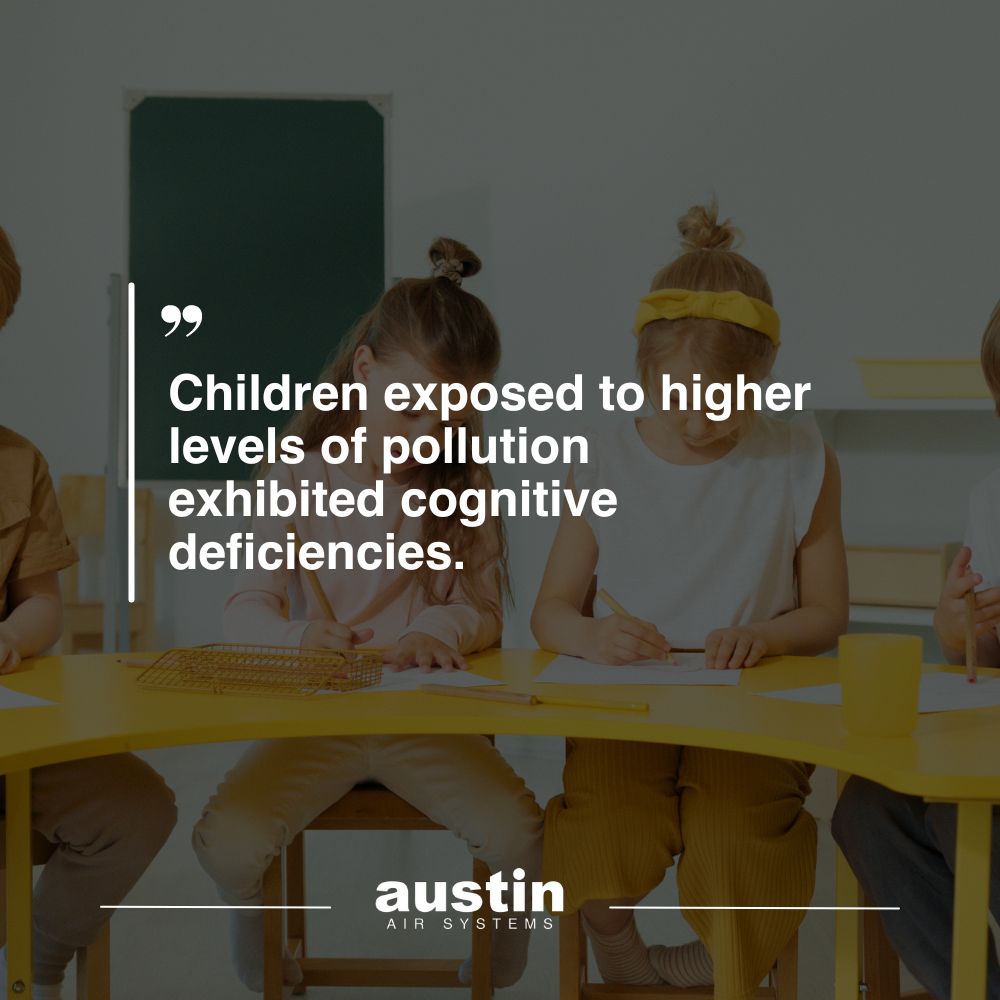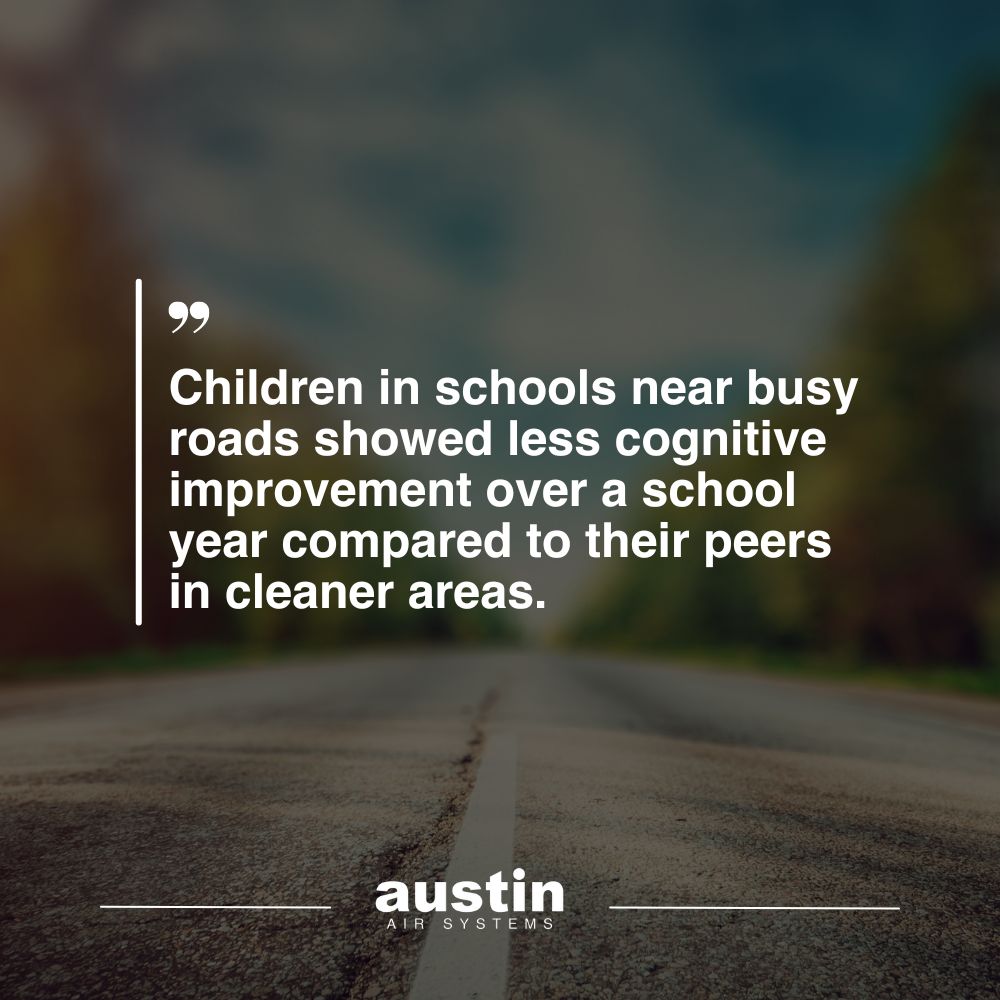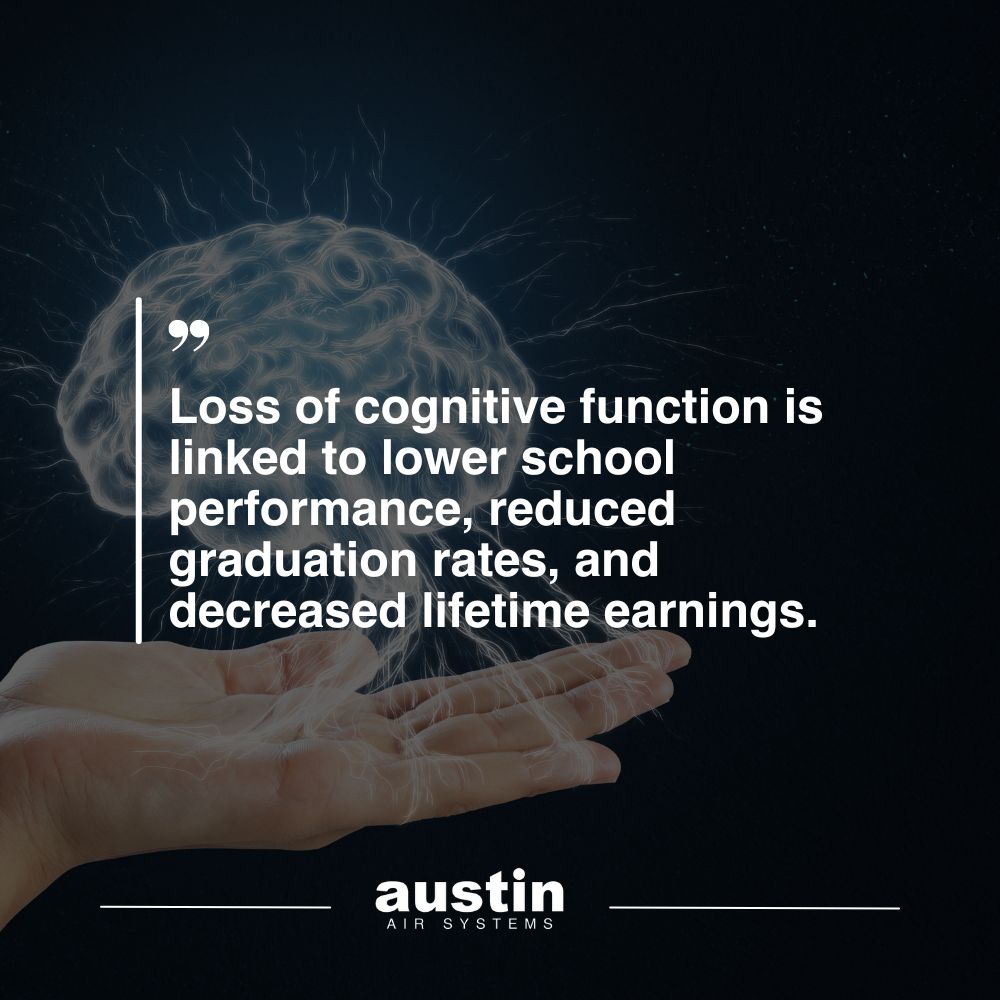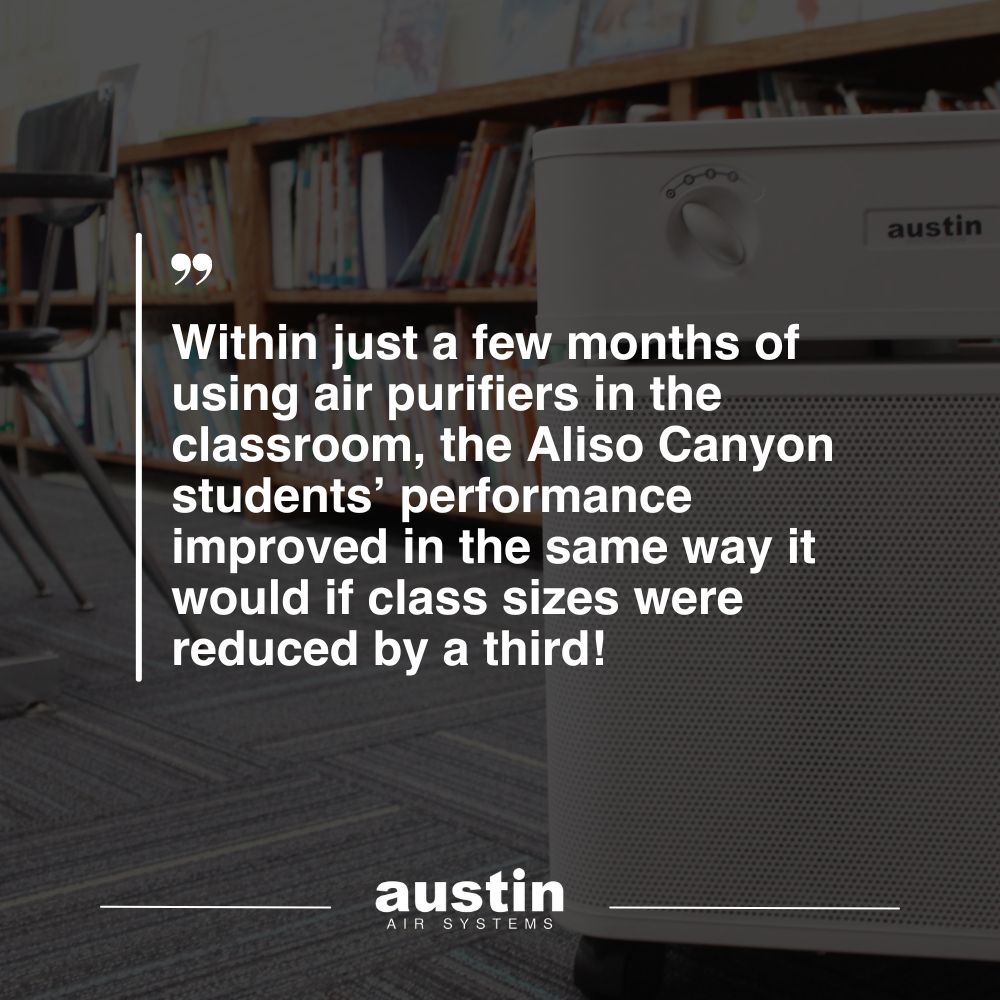Recent scientific advancements have highlighted the critical importance of clean air in educational settings. While much of the focus on air filtration has been around preventing the transmission of COVID-19, research shows that the benefits of air cleaners in the classroom extend far beyond respiratory infections.
Alarmingly, studies from Europe and North America reveal that air pollution can lower IQ scores in school-aged children. However, there’s a silver lining: introducing air purifiers in classrooms can significantly boost students’ academic performance, mirroring the benefits of reducing class sizes by 30%. This finding comes from Michael Gilraine’s study published by the Annenberg Institute of Brown University.1
Additionally, there is still time to use free federal funding to purchase portable air purifiers for classrooms!
The Dark Side of Dirty Air
For years, scientists have known that chronic exposure to air pollution has been linked to neuroinflammation, a condition that can lead to serious issues like strokes, Alzheimer’s, and Parkinson’s diseases.2 The harmful effects of air pollution also include oxidative stress, which is linked to cancer and degenerative diseases.
In light of this, researchers explored the effects of pollutants like ozone and airborne particulates on children’s brains. They chose to focus on children living in Mexico City because it is a megacity known for high pollution levels.
Children living in large cities have been found to experience neuroinflammation more frequently than their peers in other areas. The findings were startling: children exposed to higher levels of pollution exhibited cognitive deficiencies, despite not having genetic predispositions to such issues.3
The children studied were free of genetic risks for neurological or cognitive difficulties. The researchers analyzed brain and spinal fluids from children living in urban areas and compared them to those of children from less populated areas who matched in gender, age, socioeconomic status, and educational level. They also factored in the educational attainment of the children’s parents to account for non-environmental influences.
As suspected, the children living in the more populated and polluted areas had more toxins in their blood – causing damage to blood-brain barriers which can lead to serious neurological problems. The children living in the polluted area showed deficiencies with performing cognitive tasks – implying that their brain function was not as it should be, and pollution may have been the cause.
Further studies confirmed that children in more polluted urban areas had increased levels of toxins in their blood, damaging the blood-brain barrier and potentially leading to severe neurological problems.
Astonishingly, some of the children tested were producing autoantibodies against proteins in their brain!
Traffic and Cognitive Development
A study conducted in Barcelona highlighted another concerning aspect: proximity to heavy traffic negatively impacts cognitive development in children.4 Researchers compared the cognitive progress of 2,715 elementary students in high-traffic areas with those in less polluted zones. The results were clear—children in schools near busy roads showed less cognitive improvement over a school year compared to their peers in cleaner areas.
Air pollution often peaks during heavy traffic periods, which usually align with school hours. Researchers compared 2,715 elementary students from schools near busy roads to those from schools in quieter areas. They measured pollution levels inside the schools and in outdoor play areas, then assessed the cognitive development of both groups over a school year. The findings revealed that students in schools located near heavy traffic showed less progress compared to those in less trafficked areas.
Losses in IQ
Adding to the concern is research about the effects of fine particulate matter (PM2.5) air pollution on public health in Massachusetts, including its impact on children’s cognitive function.5 The researchers used publicly available data to estimate air pollution’s health impacts.
They found that PM2.5 pollution contributed to nearly 2 million Performance IQ points lost among children aged 0-9 years in 2019 – even in areas where the air pollution levels were below the standards set by the EPA.
This loss of cognitive function is linked to lower school performance, reduced graduation rates, and decreased lifetime earnings. The study highlights the need for stricter air quality standards and actions to reduce pollution, particularly as the effects are more severe in low-income, minority communities.
The Science Speaks Volumes
All of this research was groundbreaking for being interdisciplinary and showing that the environment can have a major long-term impact on brain function. The results in these studies were very preliminary due to the small number of subjects, meaning much more research was needed.
It could have taken years, even decades, for large scale scientific studies to be funded and organized for the tens of thousands of people necessary but in early 2016, the clean-up from a disaster in California provided researchers with enough data from a five-mile radius to confirm the importance of good indoor air quality and the connection to student performance.
A Natural Experiment: The Aliso Canyon Gas Leak
The Aliso Canyon gas leak began in October 2015 and continued for months causing reports of nausea, headaches, and severe nosebleeds – particularly in children. In a massive, coordinated effort, thousands of air purifiers were distributed to homes and schools in the region, including 10,000 Austin Air units. Eventually, the gas leak stopped but the air cleaners remained in use after the hazard was gone, removing common, everyday pollutants from the air that trigger allergies, asthma, and other ailments.
Michael Gilraine, a professor and researcher, looked at the math and English test scores in the schools that were using the air purifiers. Remarkably, within just a few months the students’ performance improved in the same way it would if class sizes were reduced by a third! For a five-mile radius!
Even more exciting – study authors observed these gains continued into the next school year! No expensive remodeling, no hiring of extra teachers. All it took was running an air purifier for four months to begin major improvements that have a lasting positive impact on academic performance.
Bridging the Socio-Economic Gap
Schools in low-income areas stand to gain the most from improved air quality, as they often experience worse pollution levels. Factors like a lack of green spaces, low-quality housing, and proximity to highways contribute to poorer air conditions. In places like the Bronx, where asthma education is part of the school curriculum due to its prevalence, the need for clean air is critical.
Air quality isn’t just a concern for kids in urban areas. Children in mining and agricultural communities also face exposure to harmful pollutants like metals and pesticides. By ensuring cleaner air, we can not only boost academic performance but also help bridge the socio-economic gap.
Portable air cleaners are an accessible and practical solution for schools looking to reduce airborne contaminants, including viruses, allergens, and pollutants. These devices are particularly beneficial in classrooms, where students spend a significant portion of their day. By filtering out harmful particles, air cleaners can help minimize the risk of respiratory issues, allergies, and the spread of illnesses.
This is critical in both urban and rural areas where students are exposed to poor air quality.
Leveraging ESSER Funds for Portable Air Cleaners: A Timely Investment in Student Health
Schools have a unique opportunity to enhance the safety and well-being of their students with Elementary and Secondary School Emergency Relief funds. The deadline for allocating these funds approaches on September 30th, 2024. One effective use of these funds is the purchase of portable air cleaners for classrooms, a simple yet impactful method to improve indoor air quality.
The pandemic underscored the importance of air quality in preventing disease transmission, but the benefits extend beyond COVID-19. As the research has proven, cleaner air can improve cognitive function, reduce absenteeism due to illness, and create a more comfortable and conducive learning atmosphere. As schools continue to navigate the challenges of the post-pandemic landscape, prioritizing air quality is a proactive step that can yield significant dividends.
With the ESSER funds’ allocation deadline rapidly approaching, schools should act swiftly to secure these vital resources. Investing in portable air cleaners is not just a short-term solution; it’s a commitment to the ongoing health and success of students and staff. By making this timely investment, schools can ensure they are using federal funds in a way that maximizes student safety and educational achievement.
Austin Air Parent and Teacher Toolkit: A Helpful Guide
Classifying air pollution as a neurotoxin could be a pivotal step toward cleaner air and better educational outcomes. Crucially, medical-grade air purifiers by Austin Air offer an affordable and effective solution to improve indoor air quality in schools. Austin Air cleaners have been clinically proven to enhance health outcomes for children with asthma, COPD patients, and others. The CDC recommends the filtering technology in Austin Air purifiers, which includes HEPA and activated carbon.6
Austin Air Systems has created a Parent – Teacher Toolkit to help empower folks who want to improve air quality in schools. This resource supports parents, teachers, and community members in advocating for cleaner air solutions.
Improving school air quality is an investment in our children’s health and future. Use the toolkit and ESSER III funds to make a difference this summer.
REFERENCES
1 Gilraine, Michael. Air Filters, Pollution and Student Achievement. EdWorkingPaper: 20-188. Retrieved from Annenberg Institute at Brown University: http://www.edworkingpapers.com/ai20-188.
2 Costa LG, Cole TB, Dao K, et al. (2019). Neurotoxicity of air pollution: Role of neuroinflammation. Advances in Neurotoxicology. 3: 195–221. doi: 10.1016/bs.ant.2018.10.007.
3 Calderón-Garcidueñas L, Mora-Tiscareño A, Ontiveros E, et al. (2008 June 11). Air pollution, cognitive deficits and brain abnormalities: a pilot study with children and dogs. Brain Cogn. 68(2): 117-27. doi: 10.1016/j.bandc.2008.04.008.
4 Sunyer J, Esnaola M, Alvarez-Pedrerol M, et al. (2015 March 3). Association between traffic-related air pollution in schools and cognitive development in primary school children: a prospective cohort study. PLoS Med. 12(3): e1001792. doi: 10.1371/journal.pmed.1001792.
5 Landrigan PJ, Fisher S, Kenny ME, et al. (2022 July 18). A replicable strategy for mapping air pollution’s community-level health impacts and catalyzing prevention. Environ Health. 21, 70. doi: 10.1186/s12940-022-00879-3.
6 Taking Steps for Cleaner Air for Respiratory Virus Prevention (2024 March 1). US Centers for Disease Control. https://www.cdc.gov/respiratory-viruses/prevention/air-quality.html.




